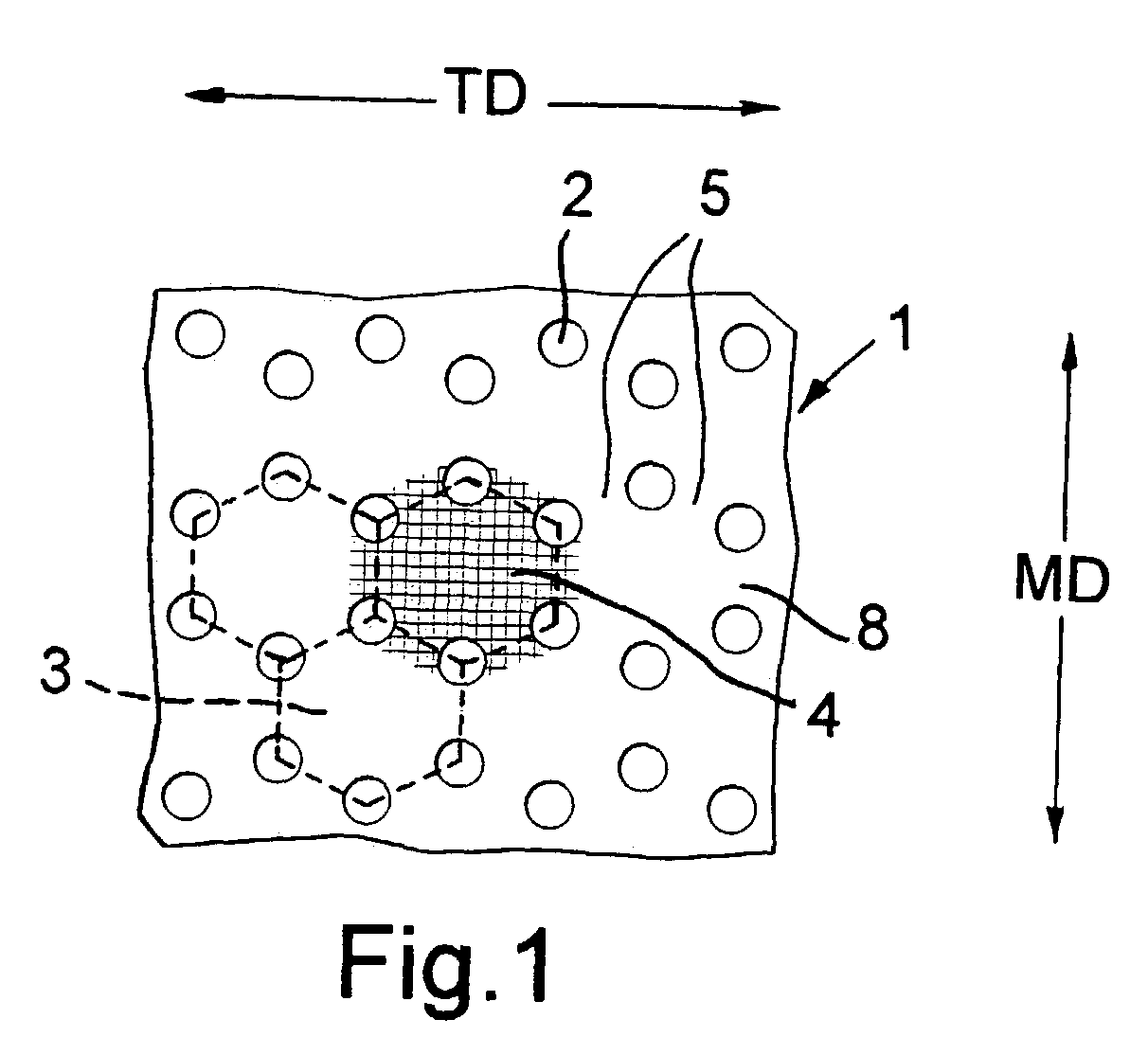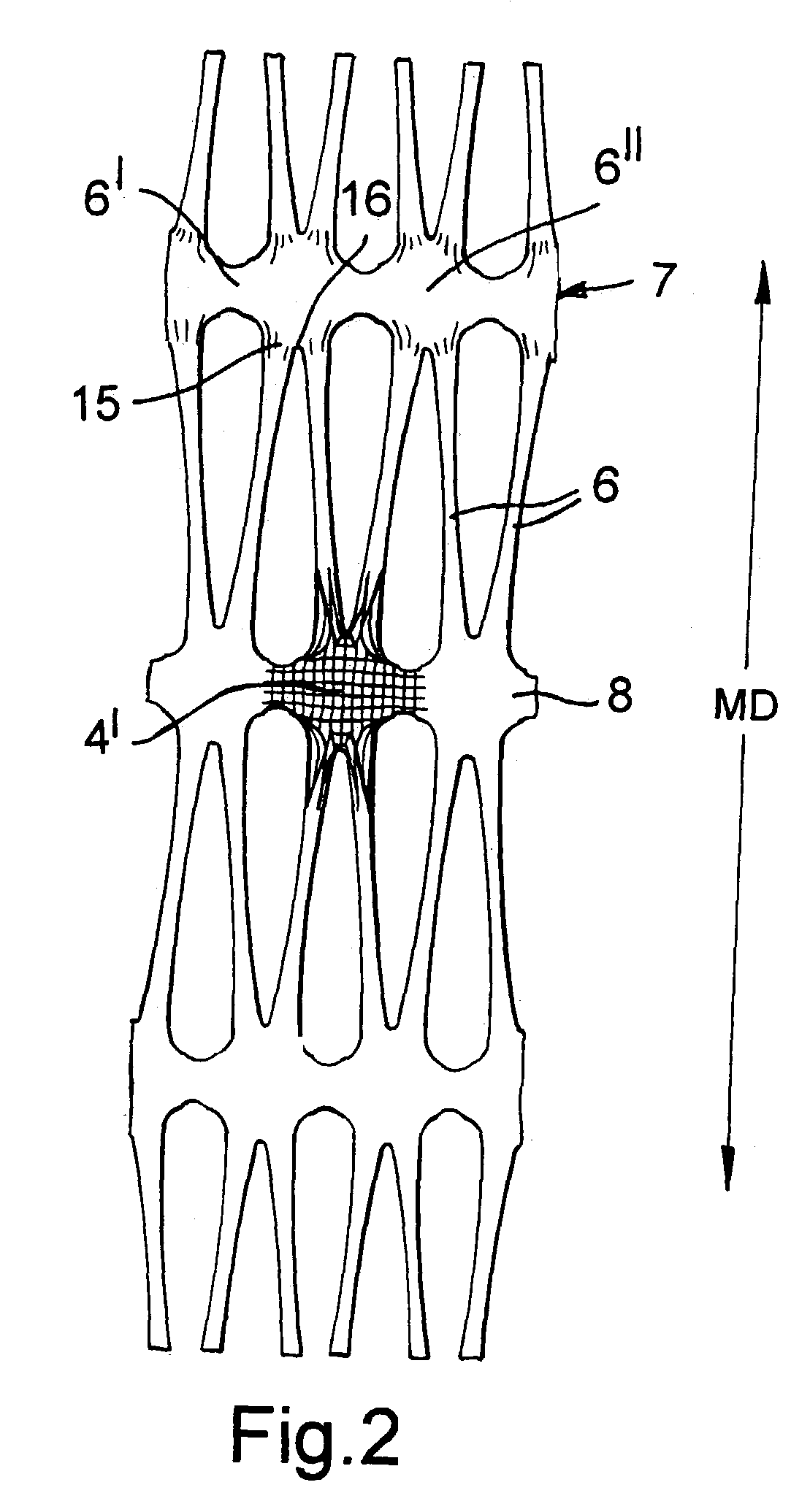Geogrid or mesh structure
- Summary
- Abstract
- Description
- Claims
- Application Information
AI Technical Summary
Benefits of technology
Problems solved by technology
Method used
Image
Examples
example 1
FIG. 7 and Example 1
[0069]FIG. 7 is an enlarged view of part of the starting material 1 of FIG. 1 and indicates the pitches (the distances between the centres) of the holes 2. The starting sheet 1 was nominally 4.7 mm thick polypropylene with 2% carbon black additive and the punch size for the holes 2 was 5 mm diameter. It will be seen that the hexagons 3 do not have equal-length sides but are slightly foreshortened in the MD and in each hexagon 3, the ratio of the distance between the centres of the two opposite holes 2 on the MD axis of the hexagon 3 (18.5 mm) to the distance between the other remaining pairs of opposite holes 2 (21.7 mm) is 0.85:1 (or 1:1.17). The major MD pitch:minor MD patch ratio is 2.625:1. The ratio of the distance apart of the centres of adjacent holes to the diameter of the holes is 2.1:1 and 2.06:1, respectively.
[0070]The starting material 1 was given a first (notional MD) stretch to an overall stretch ratio of 3.86:1, and was allowed to relax to give a s...
example 2
FIG. 8 and Example 2
[0072]FIG. 8 corresponds to FIG. 7, but the dimensions were different, as indicated in FIG. 8. The hexagons 3′ have equal-length sides. The punch size for the holes 2′ was again 5 mm diameter. The ratio of the distance apart of the centres of adjacent holes 2 to the width of the holes 2, as measured along the line connecting the centres, is 2.30:1. Other parameters were:[0073]Starting sheet thickness—4.7 mm;[0074]Major MD pitch: minor MD pitch—2.6:1;[0075]MD distance between centre lines of adjacent bars 6′ after the first stretch—60 mm.[0076]TD junction centre / junction centre distance after first stretch (after relaxation)—21.3 mm;[0077]TD junction centre / junction centre distance after second stretch (after relaxation)—69.3 mm;[0078]Intermediate MD stretch ratio (before relaxation)—3.82:1;[0079]Intermediate TD stretch ratio (before relaxation)—3.31:1 (including relaxation allowance);[0080]Final MD stretch ratio (after relaxation)—3.76:1;[0081]Final TD stretch ra...
example 3
FIG. 12 and Example 3
[0094]The starting sheet thickness, material and punch size were as in Example 1. The notional MD pitch was 10.5 mm and the notional TD pitch 9.5 mm. The punch to form the grooves 23 had a 116° included angle with a radiussed tip, and was applied to each face of the material 21 to a depth of 16% of the sheet thickness, giving a total grooving of 32% of the sheet thickness. The MD and TD stretch ratios were respectively 4.00:1 and 2.21:1. FIG. 12 indicates the thicknesses of various points on the product, in mm. The geometrical extension was 2.3%. The relative lateral displacement was 11.8%.
PUM
| Property | Measurement | Unit |
|---|---|---|
| Thickness | aaaaa | aaaaa |
| Thickness | aaaaa | aaaaa |
| Pressure | aaaaa | aaaaa |
Abstract
Description
Claims
Application Information
 Login to View More
Login to View More - R&D
- Intellectual Property
- Life Sciences
- Materials
- Tech Scout
- Unparalleled Data Quality
- Higher Quality Content
- 60% Fewer Hallucinations
Browse by: Latest US Patents, China's latest patents, Technical Efficacy Thesaurus, Application Domain, Technology Topic, Popular Technical Reports.
© 2025 PatSnap. All rights reserved.Legal|Privacy policy|Modern Slavery Act Transparency Statement|Sitemap|About US| Contact US: help@patsnap.com



